Understanding Rabbit Eyes: Anatomy and Significance
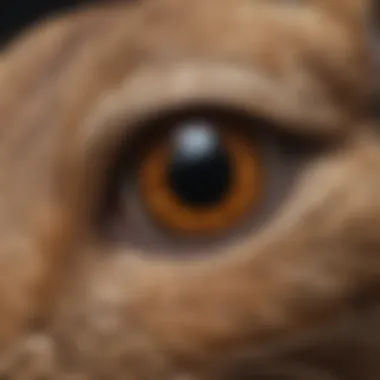
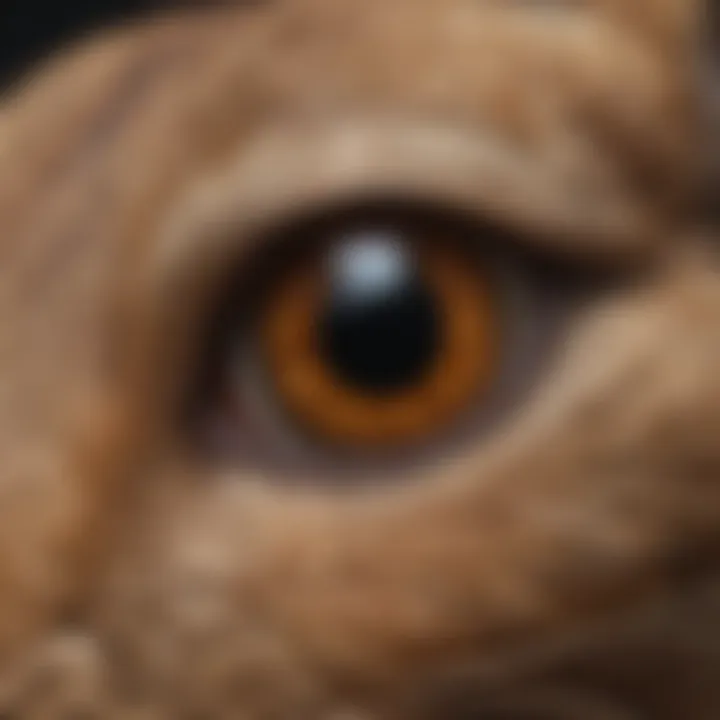
Intro
Rabbit eyes have a unique design that reflects their evolutionary history and behavioral needs. Understanding the anatomy and function of rabbit eyes is crucial for pet owners who want to optimize their rabbit's well-being. This section will provide insight into how rabbits see the world, the factors affecting their vision, and why their ocular health is essential.
Understanding Your Pet
Pet Behavior Basics
Rabbits are prey animals, which significantly influences their vision. Their eyes are positioned on the sides of their heads, allowing a nearly 360-degree field of view. This wide field enhances their ability to detect predators. However, it also means they have a blind spot directly in front of their noses.
Recognizing this behavior is vital in building trust with your rabbit. They may exhibit cautious behavior when approached, especially from the front. With patience, they can learn where they feel safe. Understanding this aspect of rabbit behavior enables owners to create a suitable environment.
Common Breed Characteristics
Different breeds of rabbits may show varied eye characteristics, like color and size. For example, the Holland Lop typically has soft, brown eyes, while the Himalayan rabbit has striking blue eyes. Each breed's eye characteristics can carry implications for health and care, often requiring specific attention during routine check-ups.
Species-Specific Needs
While all rabbits share some common visual traits, their specific needs may vary. Breeds with larger eyes may be more susceptible to issues like corneal damage. Additionally, certain breeds can have genetic predispositions to eyesight problems. Understanding these unique requirements is essential for ensuring proper sight health in your rabbit.
Health and Wellness
Routine Vet Check-ups
Regular veterinary visits are key to maintaining your rabbit's eye health. Vets can spot signs of potential problems early on. They can identify conditions like cataracts or eye infections that may develop. Keeping a consistent schedule for check-ups will help address issues promptly.
Vaccination Needs
While eye conditions may not directly relate to vaccinations, a healthy rabbit is less prone to secondary infections. Vaccinations protect against diseases that could compromise your rabbit's immune system and overall health, potentially impacting eye health too.
Recognizing Signs of Illness
Pet owners should be aware of symptoms indicating vision problems or ocular illness. Common signs can include:
- Unusual squinting or tearing
- Discharge from the eyes
- Hiding more than usual
- Changes in behavior, such as bumping into objects
If any of these symptoms arise, seeking veterinary attention promptly is necessary.
"Understanding rabbit eyes not only enhances animal welfare but gives a profound insight into their unique behavioral patterns."
Enrichment and Activities
Indoor vs. Outdoor Activities
Rabbits need mental and physical stimulation, which can be achieved through various activities. Outdoor environments provide natural stimuli, encouraging instinctual behaviors like foraging. However, precautions against predators and environmental hazards must be in place.
Interactive Toys and Games
Using toys that promote activity can further stimulate a rabbit's senses. Toys that encourage exploration and play can effectively engage their innate curiosity. Examples include chew toys and hiding food in puzzles. This can contribute to a rabbits well-being, ensuring their instincts are met, provide mental stimulation, and keep them physically active.
Socialization Opportunities
Rabbits are social creatures and benefit from interaction with other rabbits or even humans. Proper introductions are key to fostering social bonds. Daily interaction can help alleviate stress and enhance their overall quality of life.
By considering all these points about rabbit eyes and their health, pet owners can encourage a happier and more fulfilling life for their companions.
Anatomy of Rabbit Eyes
The anatomy of rabbit eyes is fundamental in understanding how these animals interact with their environment. Their eyes have evolved specifically to fulfill their needs as prey animals. The structural elements enhance their vision and adaptability, allowing them to detect danger efficiently. Knowing the anatomy can also aid pet owners in identifying issues with their rabbits' eye health, leading to better care and management.
General Structure
Rabbit eyes are large relative to their head size, providing a wide field of view. The shape of their eyes allows for extensive lateral vision, often covering nearly 360 degrees, with only a small blind spot directly in front. This feature is vital since it helps rabbits detect predators more easily. The cornea is prominently curved, which contributes to the high degree of peripheral vision. Interestingly, the placement of the eyes high on the head provides a view of the surroundings without raising their heads, which can be critical in situations where they need to stay alert to danger.
Unique Features
The unique aspects of rabbit eyes include the presence of a third eyelid, also known as a nictitating membrane. This membrane offers additional protection while maintaining visibility. It allows rabbits to blink without closing their eyes entirely, preserving moisture and cleansing debris. Another feature to mention is their capacity for night vision, which enables them to navigate in low-light conditions. The retinal structure of rabbits is specialized for detecting motion, giving them an advantage in avoiding predators.
Comparative Anatomy
Rabbits vs. Other Animals
When comparing rabbit eyes to those of other animals, one key characteristic is their size. For instance, cats also have large eyes for their head size but are designed differently, emphasizing depth over breadth of field. The rabbit's eyes are more geared toward detecting lateral movements, which is essential for its survival as prey. This distinctive trait makes rabbits particularly adept at spotting potential threats from various angles. The wide-set placement allows for a broader awareness of their surroundings.
Adaptations for Survival
Rabbits have developed adaptations that ensure their survival in the wild. The ability to see a vast area around them helps them forage and evade predators. In addition to their unique eye structure, rabbits have evolved behaviors that correspond to their vision capabilities. For example, they are often vigilant graziers, moving in a manner allowing them to observe their environment closely while feeding. This behavior reduces the time they spend in vulnerable positions and enhances their ability to escape quickly if danger approaches.
Vision in Rabbits
Understanding vision in rabbits is essential for comprehending their behavior and interactions with their environment. The eyes of rabbits are adapted for survival, allowing them to perceive the world in ways that are significantly different from humans. This section will explore key aspects of rabbit vision, including their field of view, depth perception, and color perception. Each element contributes to the rabbit's ability to detect predators, navigate their surroundings, and engage effectively with other rabbits.
Field of View
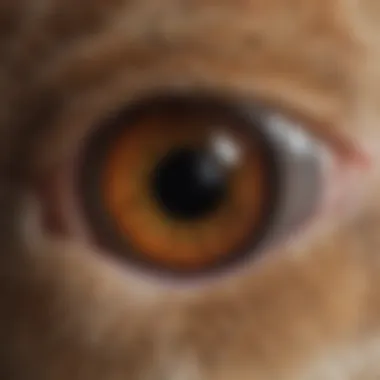
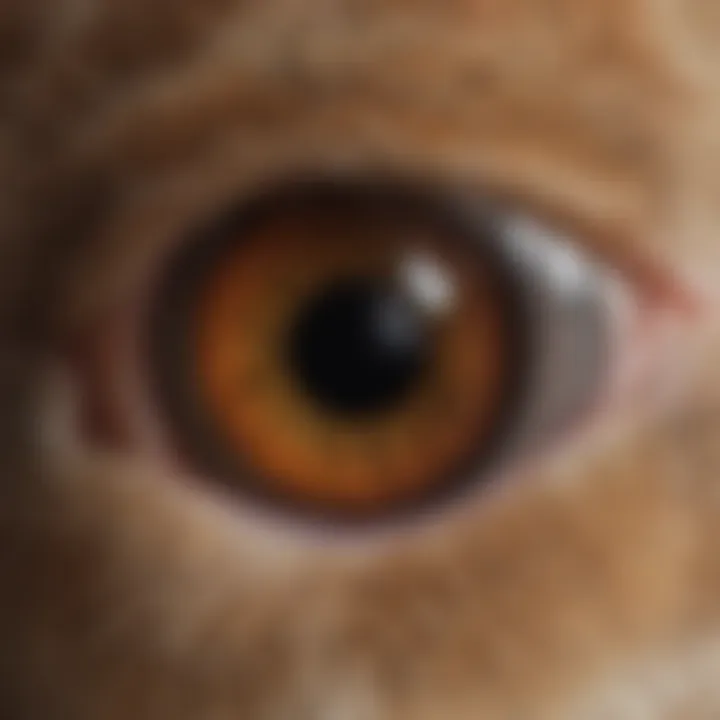
Rabbits have a remarkably wide field of view, nearly 360 degrees. This extensive peripheral vision is a direct adaptation to their status as prey animals. Their eyes are positioned on the sides of their heads, allowing them to effectively monitor their surroundings for potential threats. This characteristic is vital for early predator detection, which increases their chances of survival.
Moreover, the limitations are significant; rabbits have a small blind spot right in front of their noses. Therefore, they rely on other senses, such as smell and hearing, for close-range information. This combination of wide field of view and additional sensory input is critical for their awareness and reaction to possible dangers. An understanding of this aspect of rabbit vision can aid pet owners in creating safe environments for domestic rabbits.
Depth Perception
Depth perception in rabbits is somewhat limited compared to other animals. While their wide field of view is advantageous for spotting predators, it compromises their ability to accurately judge distances. Rabbits primarily rely on monocular vision, using one eye at a time to assess depth. This feature emphasizes the importance of spatial awareness, as a rabbit may misjudge the distance when jumping or navigating through spaces.
Understanding this limitation is crucial for rabbit owners to ensure safe environments. High enclosures or obstacles that a rabbit may navigate should be evaluated considering their limited depth perception. Therefore, maintaining a secure space free from sharp edges or hazardous heights can prevent injury and promote better exploratory behavior.
Color Perception
Rabbits do not see color in the same way humans do. Their color perception is believed to be limited mostly to shades of blue and green, with an inability to distinguish red hues effectively. This dichromatic vision has implications for their interaction with the environment. While they may not see the rich spectrum of colors humans appreciate, rabbits are highly sensitive to motion and brightness.
This sensitivity plays an essential role in detecting predators and understanding their surroundings. Understanding their color perception can guide pet owners in selecting toys and environments for their rabbits. For instance, opting for blue or green objects can make playtime more engaging for a rabbit.
"The study of rabbit vision highlights their unique adaptations, primarily serving the survival needs of these prey animals."
In summary, the vision of rabbits is defined by their wide field of view, limited depth perception, and restricted color range. These factors not only shape their behaviors but also offer insights for caring effectively for these animals in domestic settings. Understanding the visual capabilities of rabbits enhances our ability to meet their needs and provides a better quality of life.
Behavioral Implications
The study of rabbit eyes provides valuable insights into their behavior and interactions with their environment. Understanding how ocular anatomy and vision capabilities affect behavioral aspects is crucial for rabbit care. Vision directly influences how rabbits respond to predators, engage with social groups, and navigate their surroundings. Knowledge of these behavioral implications helps pet owners create better environments for their rabbits and enhances our understanding of their needs and preferences.
Predator Awareness
Rabbits have evolved with features that enhance their ability to detect predators. Their large, laterally placed eyes give them a wide field of view, nearly 360 degrees. This adaptation allows them to see behind without moving their heads, crucial for identifying lurking dangers.
Most importantly, rabbits are prey animals. Thus, their acute sight aids in early predator detection, allowing for rapid escape. The ability to spot movement from all angles keeps them safer in the wild. Therefore, when care for domestic rabbits, it is essential to minimize sudden movements or loud noises to reduce stress. Pet owners need to create a secure atmosphere that accommodates these instincts, providing hiding spaces and ensuring the rabbit feels protected.
Social Interactions
Rabbits are social creatures, often forming strong bonds with other rabbits and human caretakers. Their vision plays a role in these interactions. While they can see most colors, their vision is less vibrant than that of humans. Yet, they can notice subtle movements and familiar shapes, crucial for recognizing companions within their environment.
Rabbits communicate with each other through body language and movement. Eye contact or lack thereof can convey different messages among them. Understanding these visual cues is important for rabbit owners, as it ensures that human interactions respect the rabbit's social needs. For example, slowing movements and allowing rabbits to approach on their own terms helps to build trust and intimacy.
Navigation and Exploration
Another significant aspect of rabbit behavior is their ability to navigate and explore their territory. Their vision, despite limitations in depth perception, is adapted for spotting obstacles and the safest routes for movement. This ability is vital in both wild and domestic settings. In the wild, rabbits often move through dense vegetation, and their sight helps them identify potential hazards.
In domestic settings, providing a stimulating environment can enhance exploration. Pet owners should consider setting up tunnels, hiding treats, and varying the layout of their living spaces. By understanding their need for exploration, owners can create enriching environments that promote natural behaviors and contribute to the overall well-being of their rabbits.
Understanding rabbit behavior through the lens of their eyesight can lead to better care practices, ultimately enhancing the rabbit's quality of life.
Common Eye Conditions in Rabbits
Understanding common eye conditions in rabbits is crucial for pet owners and enthusiasts alike. Rabbits are prone to several ocular issues that can significantly impact their health and quality of life. Addressing these conditions early can prevent more serious complications. In this section, we explore three of the most prevalent eye conditions that affect rabbits: conjunctivitis, cataracts, and corneal ulcers.
Conjunctivitis
Conjunctivitis is an inflammation of the conjunctiva, the thin tissue that covers the inner eyelids and the white part of the eyeball. This condition can be caused by various factors, including allergies, infections, or foreign bodies. Symptoms may include redness, swelling, watery discharge, and pawing at the eye. Swift treatment is important, as untreated conjunctivitis may lead to further complications, such as ulcers or permanent vision impairment.
Owners should regularly check their rabbits for signs of eye discomfort. A quick response can help manage the condition effectively. Common treatments involve topical antibiotics or anti-inflammatory medications as prescribed by a veterinarian. Providing a clean environment and minimizing potential irritants can significantly reduce the risk of conjunctivitis.
Cataracts
Cataracts occur when the lens of the eye becomes cloudy, leading to blurred vision. This condition can be age-related or may develop due to genetics or nutritional deficiencies. In rabbits, cataracts often present as a noticeable cloudiness in one or both eyes. Behavior can change, as rabbits may avoid bright lights or bump into objects.
Treatment options vary, with surgery being the most effective method to restore vision in severe cases. Early detection can facilitate better outcomes, so owners need to consult with their veterinarians as soon as they notice any changes in their pet's eyes.
Corneal Ulcers
Corneal ulcers are open sores on the cornea, the clear front part of the eye. They can arise from injuries, infections, or underlying health issues. Symptoms of corneal ulcers include excessive tearing, squinting, or apparent pain in the eye. Prompt veterinary care is essential, as untreated ulcers can lead to more severe conditions, including blindness.
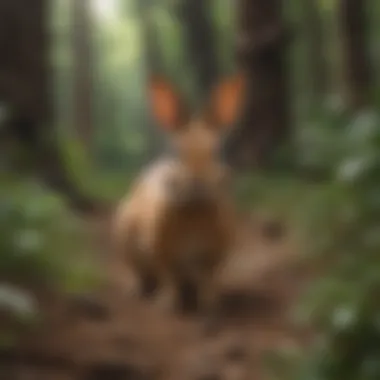

Treatment often includes topical medications, which may involve antibiotics and pain relief, while in some cases, surgery may be necessary to repair the damage. Regular observation of a rabbit’s eyes can help detect issues early, allowing for timely intervention.
Key takeaway: Maintaining your rabbit’s eye health requires vigilance. Regular checkups with a veterinarian and prompt attention to changes can lead to better outcomes and overall wellbeing.
Maintaining Rabbit Eye Health
Maintaining eye health in rabbits is crucial for their overall well-being. Rabbits rely heavily on their vision for daily activities, including feeding, social interactions, and avoiding predators. Regular attention to eye health can prevent serious issues and enhance the quality of life for these animals. Ensuring proper care includes veterinary check-ups, attentive owners, and nutritional considerations that support eye health.
Regular Veterinary Check-ups
Regular veterinary check-ups are essential for monitoring the eye health of rabbits. These visits allow professionals to assess for any signs of disease or abnormality that may not be immediately visible to the owner. A veterinarian can identify conditions like conjunctivitis, cataracts, or even more severe ocular diseases early on, leading to better outcomes.
Most vets recommend annual or biannual exams for domestic rabbits. During these check-ups, the vet will examine the eyes closely, checking for redness, discharge, and overall eye condition. Keeping a record of any changes in a rabbit's eye health can provide valuable information to the vet during these appointments.
Observational Practices for Owners
Owners play a significant role in maintaining their rabbit's eye health through daily observations. It is important to regularly check for any abnormalities. Here are some practices to consider:
- Daily Inspection: Look for signs of discharge, redness, or closed eyes. This can help in identifying issues early.
- Behavioral Changes: Notice any changes in behavior, such as reluctance to move or decreased social interactions, which may indicate vision problems.
- Grooming: Maintain clean fur around the eyes to prevent irritation or infections.
By being vigilant, owners can ensure early detection and treatment of potential eye issues, improving the overall health of their rabbits.
Nutritional Considerations
Diet significantly impacts a rabbit’s eye health. Nutritional deficiencies can lead to various eye issues, so a well-balanced diet is key. Consider the following dietary elements:
- Vitamin A: Essential for maintaining healthy eyes. Leafy greens like kale and carrots are good sources.
- Omega-3 Fatty Acids: Found in some seeds and nuts, these support overall eye function and health.
- High-Quality Hay: Provides essential fibers and nutrients that promote good digestion, which is indirectly related to eye health.
Providing a diverse diet that includes plenty of fresh vegetables can combat deficiencies and enhance eye health. Regularly review your rabbit's diet with a veterinarian to ensure all nutritional needs are met.
Keeping rabbit eyes healthy is not just about treatment but also prevention through vigilance and proper care practices that encompass diet and regular veterinary assessments.
Differences in Domestic vs. Wild Rabbit Vision
Understanding the differences in vision between domestic and wild rabbits is critical for proper care and management of pet rabbits. Each type of rabbit has unique ocular adaptations that reflect their environments and lifestyles. These differences influence how they interact with their surroundings, which is vital for both their physical and psychological well-being.
Adaptations to Environment
Wild rabbits possess exceptional adaptations that suit their needs in a natural setting. For instance, the positioning of their eyes on the sides of their heads gives them a broad field of view, allowing them to spot predators from various angles. This adaptation is crucial for their survival, as it aids in predator detection and flight response. Additionally, wild rabbits often have enhanced night vision, enabling them to navigate safely during dawn and dusk when many predators are active.
In contrast, domestic rabbits may not need such acute adaptations. They live in controlled environments where threats are minimized. However, they still retain some of the wild traits, like a wide field of view. Unlike their wild counterparts, domestic rabbits might have less pronounced night vision, which reflects their altered lifestyle. They often rely on humans for protection, reducing the need for heightened vigilance that wild rabbits require.
Impact of Domestication
Domestication has altered not only the behaviors but also the physical traits of rabbits, including their vision. Selective breeding has led to the development of various breeds with different physical features, which can impact their visual capabilities. For example, some domestic breeds have larger heads or shorter snouts, which may affect the positioning of their eyes and consequently, their visual field.
Moreover, domestic rabbits often experience reduced outdoor exposure compared to wild rabbits. This limited interaction with natural environments may affect their adaptability to changes in light and spatial orientation. Rabbits that are kept indoors might not develop the same acute visual skills required for survival in the wild.
Culmination
Overall, the differences between domestic and wild rabbit vision reflect adaptations essential for survival and well-being. Understanding these distinctions allows pet owners to create environments that cater to the natural instincts and behaviors of their rabbits, ensuring their physical health and emotional satisfaction.
"A comprehensive understanding of rabbit vision helps in nurturing their needs better and improving their quality of life as pets."
By recognizing these differences, one can appreciate the inherent complexity of rabbit care, tailored according to their environment and domestic living conditions.
Cultural and Symbolic Representations of Rabbit Eyes
The eyes of rabbits hold a special place in various cultural contexts and artistic expressions. This section explores the richness of rabbit imagery, both in literature and as symbols across different societies. Understanding these cultural representations provides insights into how the perception of rabbits transcends mere biology, entering realms of significance that affect human interactions and beliefs about these animals.
In Literature and Art
Rabbits frequently appear in literature and art, often symbolizing innocence and vulnerability. A notable example is Alice's Adventures in Wonderland by Lewis Carroll, where the White Rabbit serves as a guide through a fantastical world. In this context, the rabbit's eyes, full of urgency and apprehension, reflect a deeper emotional narrative that encourages readers to consider themes of curiosity and exploration.
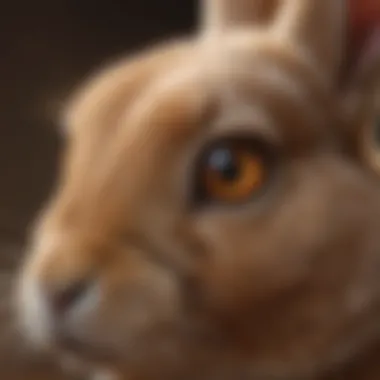
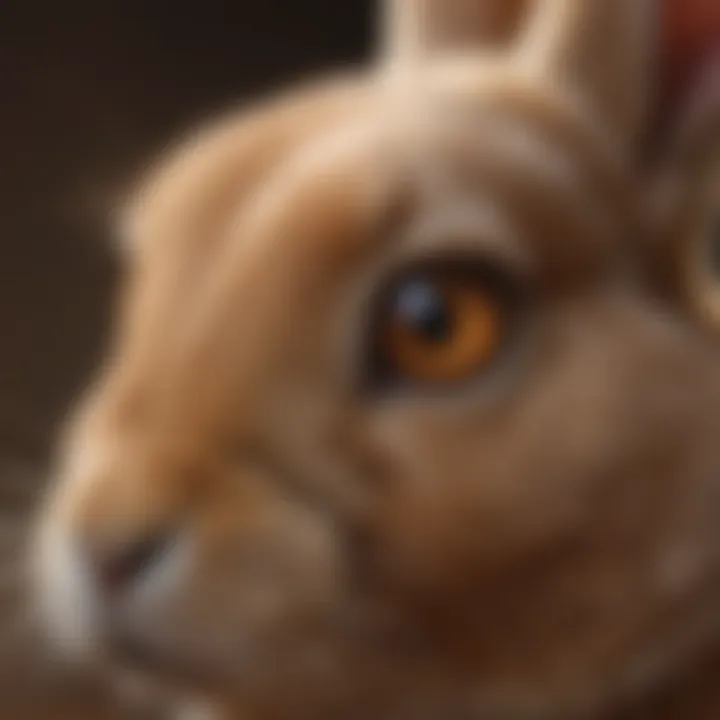
Art has similarly portrayed rabbits in diverse ways. From cave paintings to modern illustrations, these creatures are often depicted with large, expressive eyes. This representation evokes a sense of warmth and familiarity. Artists such as Beatrix Potter have amplified this notion, presenting rabbits as characters that children can relate to.
Symbolism in Different Cultures
The significance of rabbit eyes varies across cultures. In some Native American traditions, the rabbit symbolizes fertility and abundance, often depicted with wide eyes to illustrate their alertness and swift movements. This alertness extends to their role in the ecosystem, signaling their position as prey in the wild.
In Eastern cultures, rabbits can embody good fortune, particularly in the Chinese zodiac. The image of the rabbit is associated with charm and compassion, emphasizing the soft features of their eyes that symbolize gentleness. Conversely, in certain European folklore, rabbits can also represent trickery, with their bright eyes suggesting intelligence and shrewdness.
Overall, these varying interpretations affirm the importance of understanding cultural contexts when discussing rabbit eyes. They are not just tools for vision; they are imbued with meanings that resonate across generations and geographies. By contemplating the symbolic association of rabbit eyes, we can better appreciate their role beyond mere biological attributes.
Technological Advances in Veterinary Field
The intersection of technology and veterinary care is increasingly significant, especially regarding rabbit ocular health. While rabbits are often seen as simple pets, their care requires advanced knowledge and techniques. The ability to properly diagnose and treat eye conditions can greatly enhance their quality of life. Modern technology has made strides in creating diagnostic tools and surgical options that refine and improve veterinary practices for these delicate creatures.
Diagnostic Technologies
In the domain of veterinary ophthalmology, diagnostic technologies are crucial for identifying and managing eye diseases in rabbits. These technologies include advanced imaging techniques, such as ultrasound and digital photography, that allow veterinarians to capture detailed images of the internal structures of the eye.
The importance of these diagnostic tools lies in their precision and effectiveness. Here are some key advantages:
- Non-invasive Examination: Procedures like ocular ultrasound do not require significant sedation, allowing for quicker assessments and less stress for the rabbit.
- Early Detection: Advanced imaging helps in identifying conditions such as glaucoma or cataracts at early stages, which is essential for timely intervention.
- Tailored Treatment Plans: Accurate diagnoses enable vets to customize treatment regimens, reducing the risk of complications and improving outcomes.
In addition to such imaging, veterinary professionals may also use tonometry to measure intraocular pressure, assessing conditions like glaucoma with high accuracy.
Surgical Innovations
As critical as diagnostic methods, surgical innovations play a vital role in treating eye conditions in rabbits. The development of minimally invasive surgical techniques has revolutionized the field of veterinary ophthalmology, allowing for safer and more efficient procedures.
Some important facets of these innovations include:
- Laparoscopic Techniques: These allow for smaller incisions and quicker recovery times, which is particularly beneficial for rabbits that can be delicate after any surgical procedure.
- Laser Surgery: This has enabled precise corrections of eye issues, such as cataracts, without extensive damage to surrounding tissues. Laser technology reduces bleeding and facilitates faster healing.
- Enhanced Post-operative Care: With technological advances, monitoring equipment and protocols have improved, allowing for better post-operative management and reducing risks of complications.
"Investing in new technologies for rabbit care is essential not only for their health but also for the peace of mind of pet owners, knowing that their pets receive the best treatment available."
In summary, the importance of technological advances in the veterinary field cannot be overstated. Diagnostic technologies and surgical innovations provide essential tools for ensuring the ocular health of rabbits, leading to better overall care. As these technologies continue to evolve, there is hope for further improvements in the welfare of rabbits, both wild and domestic.
Future Research Directions
Research on rabbit ocular health is gaining momentum due to the increasing recognition of its importance in overall rabbit care. Understanding the intricacies of rabbit vision can inform better practices for care and health management. Investigating new areas of study regarding this topic could lead to significant advancements. The benefits stem from improved diagnosis, treatment options, and preventive measures, allowing for better health outcomes in rabbits.
Emerging Studies on Rabbit Ocular Health
Recent studies have aimed to explore the effects of various environmental factors on rabbit eye health. For example:
- Light Sensitivity: Research indicates that excessive bright light can harm rabbit vision over time, leading to conditions like cataracts.
- Diet Impact: Emerging evidence points to the correlation between nutrition and ocular health. Specific nutrients might enhance vision clarity or reduce the risk of diseases.
- Genetic Factors: Scientists are looking into hereditary conditions affecting eyesight. Understanding these could lead to tailored breeding strategies to eliminate eye-related issues.
These areas of investigation underscore the necessity of ongoing research in the veterinary field, particularly to optimize environments and care strategies for domestic rabbits.
Potential Therapies and Treatments
As our understanding of rabbit eye conditions expands, so do the treatment options available. Current treatments range from traditional approaches to emerging therapies, including:
- Surgical Interventions: Minimally invasive techniques are now utilized to correct anatomical issues within the eye.
- Medicinal Advances: New medications are being developed to manage common conditions, such as conjunctivitis and ulcerations.
- Preventive Treatments: Vaccines and supplements designed to bolster eye health are being investigated, offering a proactive approach to eye care.
One effective example is the use of antioxidant-rich supplements which might protect the eyes from oxidative stress, potentially reducing the risk of cataracts.
In summary, these research directions and potential treatments form the foundation for future improvements in rabbit ocular health. They highlight the importance of informed care, ensuring that both pet owners and professionals are equipped to enhance the quality of life for these animals.
Ending
The conclusion of an article on rabbit eyes is a critical component that encapsulates the main discussions presented. It serves as a summary of key insights, presenting the significant aspects of rabbit ocular health and anatomy while also underscoring the practical implications for rabbit owners. Understanding rabbit vision goes beyond scientific curiosity. It has direct relevance to their care, welfare, and overall quality of life.
Summary of Key Insights
In summary, rabbit eyes are uniquely structured, facilitating a remarkable field of vision that plays a pivotal role in their survival. Key insights from the article include:
- Anatomical Design: Rabbit eyes are located on the sides of their heads, granting them nearly a 360-degree field of view. This structural trait is essential for spotting predators.
- Behavioral Impact: The ability to see wide ranges influences their interaction with their environment. Their excellent night vision allows them to thrive during dawn and dusk.
- Health Considerations: Various conditions, like conjunctivitis and corneal ulcers, can affect rabbit eyes. Regular health checks can identify these issues early.
- Adaptation to Domestication: Domestic rabbits may face different challenges compared to wild counterparts, affecting their eye health and care needs. Understanding these differences is vital for responsible pet ownership.
Final Thoughts on Rabbit Eye Care
Overall, responsible rabbit care requires awareness of the specific needs regarding eye health. Pet owners should be vigilant about recognizing any signs of discomfort or unusual behavior in their rabbits. Proper nutrition, regular veterinary check-ups, and an understanding of the physiological traits that affect vision are all paramount.







